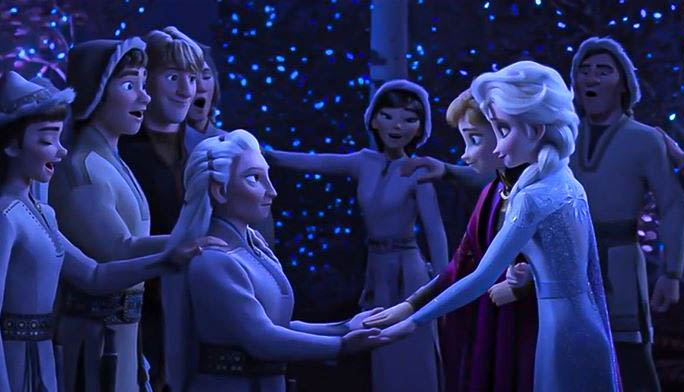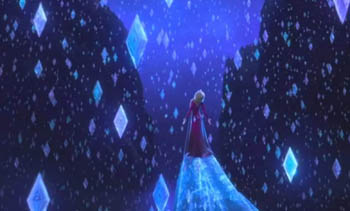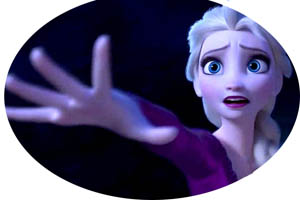Movies & Shows
 |
 |
 |
 |
 |
 |
 |
‘Into the Unknown’: Occult Tribalism
Salwa Bachar
It seems Frozen 2 can be summed up by its opening number “Into the Unknown,” where Elsa the magical Snow Queen tries to follow a mysterious voice “into the unknown.” Is Elsa’s journey in Frozen 2 actually a journey into the occult? This is the question that I will try to answer in these reviews.
 Background
Background
The animated film Frozen 2 was released late November of 2019. Targeted towards children, it is the continuation of Frozen 1. Frozen 2 takes place a short time after the events of the first movie, which was loosely based on the 19th century fairy tale by Hans Christian Andersen called The Snow Queen.
Frozen 1 blurred the lines between good and evil by making Elsa – who was supposed to be the villain, according to the original fairy tale – the hero of the movie. Elsa was born with magical ice powers, then she comes to terms with her magic by freeing herself from moral restraints, as she sings in Frozen 1: “No right, no wrong, no rules for me, I’m free.” All of Arendelle – the fictional Nordic kingdom of which she is Queen – learns to accept her and her magic as normal.
Frozen 2 continues on the same path, this time going explicitly into occult tribalism and anti-colonialism, both with a feminist twist. Upon hearing a mysterious voice calling her, Elsa goes on a quest to discover why she was given powers. She discovers she is a descendant of an indigenous Nordic tribe called the Northuldra, which lives in harmony with nature and harnesses the magic of the four elemental spirits.
Elsa learns to tame the four spirits, which demands that a “wrong” action from the past must be “righted.” She learns that her grandfather, King Runeard of Arendelle, tricked the Northuldra leader into building a dam on their territory in order to exploit the tribe’s resources and later murdered him. Elsa reveals to her sister Anna that, in order to “right this wrong,” she must destroy the dam, which Anna does.
In the end, Elsa learns that her real mission is to unite the four elemental spirits and thus restore balance in the world; by doing this she becomes the fifth elemental spirit. She abdicates the throne of Arendelle and goes to live with the Northuldra as the “mediator between humans and the magic of nature,” becoming a bridge between the living and the spirit world. The full synopsis of Frozen 2 can be found here.
Northuldra & Sami: Tribalism
The directors of the movie admit that the Northuldra tribe was modeled after the Sami people, an indigenous Finno-Ugric tribe that inhabits Norway, Sweden, Finland and parts of Russia. The Sami people practice pagan animism.
According to scholars from the University of Texas, Austin, the Sami “believe in a world populated by spirits and deities that are an organic part of nature itself. Every creature has a spirit and significance. The Sami feel that everything in their world is connected through these spirits.”
 This seems to be almost exactly what the movie portrays: The Northuldra tribe is presented as an indigenous people who are connected to nature, harnessing the magic of the elemental spirits, which keep everything in balance. For example, when the Northuldra leader meets Elsa, saying: “We are Northuldra. We are the people of the Sun.” In their pagan religion, the Sami people actually believe they are descendants of the Sun god.
This seems to be almost exactly what the movie portrays: The Northuldra tribe is presented as an indigenous people who are connected to nature, harnessing the magic of the elemental spirits, which keep everything in balance. For example, when the Northuldra leader meets Elsa, saying: “We are Northuldra. We are the people of the Sun.” In their pagan religion, the Sami people actually believe they are descendants of the Sun god.
The viewer is induced to sympathize with the Northuldra (and by extension, the pagan Sami tribe in real life); in the end Elsa, the “hero” of the movie, goes to live with the Northuldra, embracing their tribal and pagan way of life.
Paganism & Magic
The paganism in the movie is not limited to that of the Sami people, but also borrows heavily from Norse pagan mythology (see more here). One example among many is the appearance of runes, which feature prominently in the film.
Runes are Norse written letters that are specially tied to magic. They were used to cast spells, and are still used for this as well as divination by New Age practitioners. Thomas Bacon from Screenrant.com confirms this:
 “Ancient Nordic peoples did indeed believe the runes were powerful, and it was popularly thought they had been a gift from the throne of Odin [the Norse god of magic] himself. To use a rune without proper training was to risk invoking the wrath of the gods; as one Viking poet put it: ‘Let no man carve runes to cast a spell, save first he learns to read them well.’”
“Ancient Nordic peoples did indeed believe the runes were powerful, and it was popularly thought they had been a gift from the throne of Odin [the Norse god of magic] himself. To use a rune without proper training was to risk invoking the wrath of the gods; as one Viking poet put it: ‘Let no man carve runes to cast a spell, save first he learns to read them well.’”
The runes in the movie are presented as normal and harmless, when in reality, runes are tools for divination and magic, something that goes directly against the First Commandment: “I am the Lord your God: You shall not have strange gods before me.”
Another example of magic in the movie is the appearance of trolls. In Frozen 1 and Frozen 2 the trolls are seen as helpers to Arendelle, and are always summoned by Arendelle’s royalty whenever a magical problem arises. The trolls carry magic crystals around their necks, which are said to channel the Aurora Borealis.
The trolls can alter the memories of an individual human, have healing powers and can foretell the future. In other words, they are essentially witch-doctors/shamans. The troll leader plays a crucial role in telling Elsa what she must do to fulfill her mission and to “right the wrong” of the past, showing her a colorful vision of the future in the air.
 The only character who opposes magic is presented as evil: When Elsa sees a holographic ice projection of the past in Ahtohallan – the frozen river that contains all the memories of the past – she sees King Runeard, her grandfather, speaking to one of his guards about the Northuldra, saying: "Magic makes people feel too powerful, too entitled. It makes them think they can defy the will of a king."
The only character who opposes magic is presented as evil: When Elsa sees a holographic ice projection of the past in Ahtohallan – the frozen river that contains all the memories of the past – she sees King Runeard, her grandfather, speaking to one of his guards about the Northuldra, saying: "Magic makes people feel too powerful, too entitled. It makes them think they can defy the will of a king."
Elsa responds to the holographic projection: “That is not what magic does. That is just your fear. Fear is what can't be trusted.”
Again, all this accustoms children and youth to the crystals, divination and “healing” used by New-Age/occult practitioners, witches and shamans. The occult world of magic is presented as something normal, and those who oppose magic (like King Runeard – and by extension the Catholic Church) are presented as power-hungry, fearful and bigoted.
There is also a political implication in the movie that it is good to point out. In Amazonia, which today is considered the El Dorado of Tribalism, the great enemies of the Indians presented by the Left – Progressivism, Ecology and Communism – are the local governments that want to build dams to supposedly "exploit" the energetic potential of the rivers.
In Frozen 2, the entire plot turns around the evil action of King Runeard building a dam to "exploit" the Indians. It is easy to see that the movie influences its viewers to consider dam-building bad and take a position against the proposed power-plants in Amazonia and any other place where Indians live.
Is it a coincidence that Frozen 2 was released shortly after the Amazon Synod? I don't think so. Continued
Continued


Disney comes out with another feminist film that also promotes the occult & tribalism
The animated film Frozen 2 was released late November of 2019. Targeted towards children, it is the continuation of Frozen 1. Frozen 2 takes place a short time after the events of the first movie, which was loosely based on the 19th century fairy tale by Hans Christian Andersen called The Snow Queen.
Frozen 1 blurred the lines between good and evil by making Elsa – who was supposed to be the villain, according to the original fairy tale – the hero of the movie. Elsa was born with magical ice powers, then she comes to terms with her magic by freeing herself from moral restraints, as she sings in Frozen 1: “No right, no wrong, no rules for me, I’m free.” All of Arendelle – the fictional Nordic kingdom of which she is Queen – learns to accept her and her magic as normal.
Frozen 2 continues on the same path, this time going explicitly into occult tribalism and anti-colonialism, both with a feminist twist. Upon hearing a mysterious voice calling her, Elsa goes on a quest to discover why she was given powers. She discovers she is a descendant of an indigenous Nordic tribe called the Northuldra, which lives in harmony with nature and harnesses the magic of the four elemental spirits.
Elsa learns to tame the four spirits, which demands that a “wrong” action from the past must be “righted.” She learns that her grandfather, King Runeard of Arendelle, tricked the Northuldra leader into building a dam on their territory in order to exploit the tribe’s resources and later murdered him. Elsa reveals to her sister Anna that, in order to “right this wrong,” she must destroy the dam, which Anna does.
In the end, Elsa learns that her real mission is to unite the four elemental spirits and thus restore balance in the world; by doing this she becomes the fifth elemental spirit. She abdicates the throne of Arendelle and goes to live with the Northuldra as the “mediator between humans and the magic of nature,” becoming a bridge between the living and the spirit world. The full synopsis of Frozen 2 can be found here.
Northuldra & Sami: Tribalism
The directors of the movie admit that the Northuldra tribe was modeled after the Sami people, an indigenous Finno-Ugric tribe that inhabits Norway, Sweden, Finland and parts of Russia. The Sami people practice pagan animism.
According to scholars from the University of Texas, Austin, the Sami “believe in a world populated by spirits and deities that are an organic part of nature itself. Every creature has a spirit and significance. The Sami feel that everything in their world is connected through these spirits.”

Elsa and Anna unite with the Northuldran leader - a woman of course - in a pagan chant
The viewer is induced to sympathize with the Northuldra (and by extension, the pagan Sami tribe in real life); in the end Elsa, the “hero” of the movie, goes to live with the Northuldra, embracing their tribal and pagan way of life.
Paganism & Magic
The paganism in the movie is not limited to that of the Sami people, but also borrows heavily from Norse pagan mythology (see more here). One example among many is the appearance of runes, which feature prominently in the film.
Runes are Norse written letters that are specially tied to magic. They were used to cast spells, and are still used for this as well as divination by New Age practitioners. Thomas Bacon from Screenrant.com confirms this:

Elsa releases runes to awaken the four elemental spirits
The runes in the movie are presented as normal and harmless, when in reality, runes are tools for divination and magic, something that goes directly against the First Commandment: “I am the Lord your God: You shall not have strange gods before me.”
Another example of magic in the movie is the appearance of trolls. In Frozen 1 and Frozen 2 the trolls are seen as helpers to Arendelle, and are always summoned by Arendelle’s royalty whenever a magical problem arises. The trolls carry magic crystals around their necks, which are said to channel the Aurora Borealis.
The trolls can alter the memories of an individual human, have healing powers and can foretell the future. In other words, they are essentially witch-doctors/shamans. The troll leader plays a crucial role in telling Elsa what she must do to fulfill her mission and to “right the wrong” of the past, showing her a colorful vision of the future in the air.

Elsa: the model of feminist power in the world of the occult and paganism
Elsa responds to the holographic projection: “That is not what magic does. That is just your fear. Fear is what can't be trusted.”
Again, all this accustoms children and youth to the crystals, divination and “healing” used by New-Age/occult practitioners, witches and shamans. The occult world of magic is presented as something normal, and those who oppose magic (like King Runeard – and by extension the Catholic Church) are presented as power-hungry, fearful and bigoted.
There is also a political implication in the movie that it is good to point out. In Amazonia, which today is considered the El Dorado of Tribalism, the great enemies of the Indians presented by the Left – Progressivism, Ecology and Communism – are the local governments that want to build dams to supposedly "exploit" the energetic potential of the rivers.
In Frozen 2, the entire plot turns around the evil action of King Runeard building a dam to "exploit" the Indians. It is easy to see that the movie influences its viewers to consider dam-building bad and take a position against the proposed power-plants in Amazonia and any other place where Indians live.
Is it a coincidence that Frozen 2 was released shortly after the Amazon Synod? I don't think so.

A dangerous invitation to follow Elsa
into the world of 'the unknown'

Posted January 10, 2020
______________________
______________________





